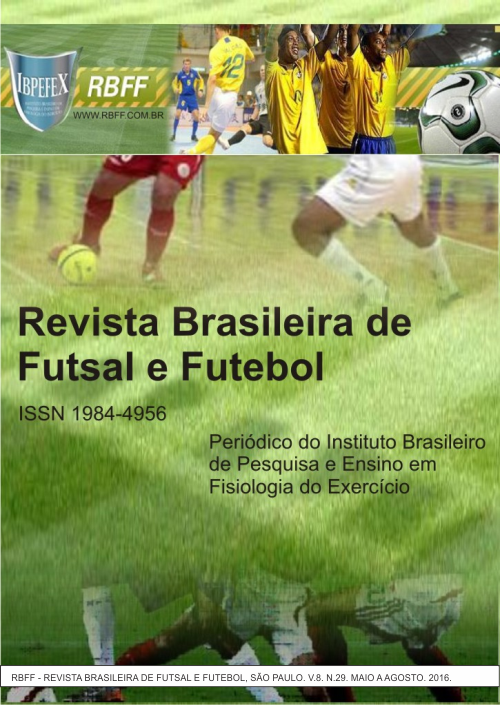The reduced game influence the target answer, distance and adolescents speed players
Abstract
The aim of this study was to analyze the interference of the number of goals in small-sided games (SG) on the distance traveled, affective responses (Feeling Scale, PSE) and speed of young footballers. Participated 12 male athlete's (16.9 ± 0.8y; 62.24 ± 7.3kg; 1.71 ± 0.1m; 21.32 ± 1.6kg/m²). We analyzed two training session: 1) SG 3 x 3 with one goal; 2) SG 3 x 3 with three goals to each team. For comparison in covered distance and RPE utilized Test T for dependent sample. The variable affect, utilized Chi-square test. For analysis in repeated sprints (baseline, SG with one beam and SG with three beam) utilized ANOVA repeated measures. Adopted significance for p<0.05. The covered distance was different between the SG, and the game with three goals (2.610 ± 0.4m) higher than the SG of one goal (2.400 ± 0.2m) (p<0.01). The affection was significantly different, and the game with three goals (1.67 ± 1.5), the more pleasurable the game single-goal (0.92 ± 3.2). The RPE was no significant difference between the SG (p = 0.14), however there was a trend toward greater effort on SG with one beam (16.42 ± 2.27) compared with the game of three beams (15.08 ± 2.5). The sprints repeated test at baseline and after both SG did not differ (p = 0.98). The small game with three beams generated a greater sense of pleasure even athletes traveling a greater distance compared to the game with one goals.
References
-Abrantes, C.I.; Nunes, M. I.; Maçãs, V. M.; Leite, N. M.; Sampaio, J. E. Effects of the number of players and game type constraints on heart rate, rating of perceived exertion, and technical actions of small-sided soccer games. The Journal of Strength & Conditioning Research. Vol. 26. Num. 4. p. 976-981. 2012.
-Bangsbo, J. The physiology of soccer--with special reference to intense intermittent exercise. Acta Physiologica Scandinavica. Supplementum. Vol. 619. p. 1-155. 1993.
-Borg, G. A. Psychophysical bases of perceived exertion. Med sci sports exerc. Vol.14. Num. 5. p. 377-381. 1982.
-Brandes, M.; Heitmann, A.; Müller, L. Physical responses of different small-sided game formats in elite youth soccer players. The Journal of Strength & Conditioning Research. Vol. 26. Num 5. p. 1353-1360. 2012.
-Castellano, J.; Casamichana, D.; Dellal, A. Influence of game format and number of players on heart rate responses and physical demands in small-sided soccer games. The Journal of Strength & Conditioning Research. Vol. 27. Num. 5. p. 1295-1303. 2013.
-Coutts, A. J.; Rampinini, E.; Marcora, S. M.; Castagna, C.; Impellizzeri, F. M. Heart rate and blood lactate correlates of perceived exertion during small-sided soccer games. Journal of Science and Medicine in Sport. Vol. 12. Num. 1. p. 79-84. 2009.
-Gabbett, T.; Jenkins, D.; Abernethy, B. Game-based training for improving skill and physical fitness in team sport athletes. International Journal of Sports Science and Coaching. Vol. 4. Num. 2. p. 273-283. 2009.
-Hardy, C. J.; Rejeski, W. J. Not what, but how one feels: The measurement of affect during exercise. J Sport Exerc Psychol. Vol. 11. Num. 3. p. 304-317. 1989.
-Halouani, J.; Chtourou, H.; Dellal, A.; Chaouachi, A.; Chamari, K. Physiological responses according to rules changes during 3 vs. 3 small-sided games in youth soccer players: stop-ball vs. small-goals rules. Journal of sports sciences. Vol. 32. Num.15. p. 1485-1490. 2014.
-Halson, S. L. Monitoring Training Load to Understand Fatigue in Athletes. Sports Medicine. Vol. 44. Num. 2. p. 139-S147. 2014.
-Hill-Haas, S. V.; Dawson, B.; Impellizzeri, F. M.; Coutts, A. J. Physiology of small-sided games training in football. Sports medicine, Vol. 41. Num. 3. p. 199-220. 2011.
-Kelly, D. M.; Drust, B. The effect of pitch dimensions on heart rate responses and technical demands of small-sided soccer games in elite players. Journal of Science and Medicine in Sport. Vol. 12. Num. 4. p. 475-479. 2009.
-Little, T.; Williams, A. G. Measures of exercise intensity during soccer training drills with professional soccer players. The Journal of Strength & Conditioning Research. Vol. 21. Num. 2. p. 367-371. 2007.
-Rampinini, E.; Impellizzeri, F. M.; Castagna, C.; Abt, G.; Chamari, K.; Sassi, A.; Marcora, S. M. Factors influencing physiological responses to small-sided soccer games. Journal of sports sciences. Vol. 25. Num. 6. p. 659-666. 2007a.
-Rampinini, E.; Bishop, D.; Marcora, S. M.; Ferrari Bravo, D.; Sassi, R.; Impellizzeri, F. M. Validity of simple field tests as indicators of match-related physical performance in top-level professional soccer players. International journal of sports medicine. Vol. 28. Num. 3. p. 228. 2007b.
-Reed, J. Acute physical activity and self-reported affect: A review. In A. V. Clark (Ed.), Causes, role and influence of mood states. Chicago.IL: Nova Science Publishers, Inc.
-Thomas, J. R.; Nelson, J. K.; Silverman, S. J. Métodos de pesquisa em atividade física. Artmed. 2012.
-Williams, D. M.; Dunsiger, S.; Ciccoli, J. T.; Lewis, B. A.; Albrecht, A. E.; Marcus, B. H. Acute affective responses to a moderate-intensity exercise stimulus predicts physical activity participation 6 and 12 months later. Psychology of Sport & Exercise. Vol. 9. Num. 3. p. 231-245. 2008.
Authors who publish in this journal agree to the following terms:
- Authors retain the copyright and grant the journal the right of first publication, with work simultaneously licensed under the Creative Commons Attribution License BY-NC which allows the sharing of the work with acknowledgment of the authorship of the work and initial publication in this journal.
- Authors are authorized to enter into additional contracts separately for non-exclusive distribution of the version of the work published in this journal (eg, publishing in institutional repository or book chapter), with acknowledgment of authorship and initial publication in this journal.
- Authors are allowed and encouraged to post and distribute their work online (eg, in institutional repositories or on their personal page) at any point before or during the editorial process, as this can bring about productive change as well as increase impact and impact. citation of published work (See The Effect of Free Access).





